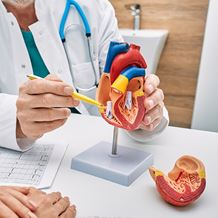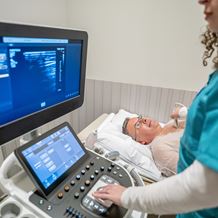
- Home
- Services
- Cardiac Services
- Conditions
- Ventricular Septal Defect (VSD)
What is Ventricular Septal Defect?
A ventricular septal defect (VSD) occurs when there is a hole in the wall of muscle that separates the lower chambers of the heart. It is an extremely common congenital heart defect that is often not detected until adulthood. Ordinarily, this part of the heart wall would separate out the oxygen-poor blood destined for your lungs, from the oxygen-rich blood that will get distributed around your body. If there is a large enough hole in the heart wall, the different types of blood will leak between the heart chambers. Extra blood will then get sent to the lungs, placing an abnormal amount of pressure on the heart. There are four main types of ventricular septal defect that are all categorised by location, size and structure. The most common type is membranous, and this is located in the upper section of the heart wall.
Symptoms and causes
The exact cause of VSD remains unknown, although it is often diagnosed alongside other heart defects, and can be a complication of a heart attack. Certain genetics and lifestyle factors are thought to increase the risk of congenital heart defects in babies. This includes smoking, alcohol and certain prescription medications. Symptoms in children are similar to those of heart failure and include:
- Shortness of breath
- Sweating
- Failure to thrive
- Frequent respiratory infections
- Adult symptoms may include:
- Quick to fatigue when exercising
- Bluish tinge of lips and skin
- Heart murmur
How is it diagnosed?
- Physical examination – heart murmurs can be identified using a stethoscope
- Echocardiogram – soundwaves create pictures to show how the blood is moving through the heart
- ECG (electrocardiogram) – to record the electrical activity of the heart and test for an irregular heartbeat
- Chest X-ray – to investigate the structure of the heart
- Cardiac MRI – radio waves give a detailed image of the heart
- CT scan – a series of X-rays help give detailed pictures of the heart
How is it treated?
VSD holes can vary in size, and in many cases will generally close up by themselves. If the heart defect is small, it is possible that no treatment is necessary. If the VSD is considered moderately sized or large, your doctor may recommend surgical repair. This can be performed either through open surgery where the hole is stitched shut possibly using a graft or patch, or the hole is closed by using a catheter-based approach where the heart is accessed through an artery. A special tool is used to patch the hole. Heart tissue then naturally grows over the patches as they form part of the new heart wall.

Other conditions
What's next?
If you have been experiencing heart-related symptoms, book an appointment with our cardiac services specialist today.
Our specialists in Cardiac Services
View all specialists




